Ken Burns’s PBS series The War presents World War II as earth’s darkest hour—and the Americans who endured it as people whose stories we need to hear.
by Tom Huntington
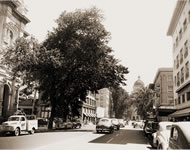 No one can say Ken Burns lacks ambition. He has a history of tackling big subjects in sweeping, multi-part documentaries like The Civil War, Jazz, and Baseball. His new film fits that mold. Premiering on PBS on September 23, The War is a seven-part epic on the biggest subject Burns has taken on yet: the global conflict he calls “the greatest cataclysm in human history.” That would be World War II, of course, and it is indeed a big topic, one perfectly suitable for a typically big Ken Burns documentary. But even after viewers have watched all 14 1/2 hours of the documentary, they shouldn’t expect to walk away with an encyclopedic knowledge of the war. “At the end of this you’ll know the essential parameters of the Second World War, and you’ll also know maybe 40 battles, but there will be a lot of stuff left out,” Burns says, talking on the phone from his home in New Hampshire.
No one can say Ken Burns lacks ambition. He has a history of tackling big subjects in sweeping, multi-part documentaries like The Civil War, Jazz, and Baseball. His new film fits that mold. Premiering on PBS on September 23, The War is a seven-part epic on the biggest subject Burns has taken on yet: the global conflict he calls “the greatest cataclysm in human history.” That would be World War II, of course, and it is indeed a big topic, one perfectly suitable for a typically big Ken Burns documentary. But even after viewers have watched all 14 1/2 hours of the documentary, they shouldn’t expect to walk away with an encyclopedic knowledge of the war. “At the end of this you’ll know the essential parameters of the Second World War, and you’ll also know maybe 40 battles, but there will be a lot of stuff left out,” Burns says, talking on the phone from his home in New Hampshire.
“I’ve described myself as an emotional archaeologist,” he says. “I’m not interested in excavating the dry dates and facts and events of the past. That’s boring. That’s homework. I’m interested in this kind of rich, powerful, emotional stew that comes out from understanding how similar those lives were to our own in terms of their hopes and their wishes and their dreams, their disappointments and tragedies.”
When he was a boy, Burns fought the Nazis, like kids his age all over the country (he was born in 1953). “I dug trenches, much to my mother’s dismay, in my backyard in the ’50s, and killed Germans with my brother,” he says. When he embarked on The War, though, Burns lacked a deep knowledge of World War II. “I didn’t know that much about it,” he says. “In fact, all of my films I have not tried to make a film about something I know, because there could be nothing more boring than somebody telling you what they already know, an essay or a lecture or a seminar.”
Like the Civil War, the Second World War has been studied and scrutinized in painstaking detail over the years. The sheer weight of what came before “might have exempted us from trying” a new exploration of the subject, admits Burns. But previous histories were different from what he wanted to do, he says; they tended to be either intimate or contextual. “The intimate ones dropped you into a specific moment an intimate moment but gave you no context, and the ones that gave you context didn’t give you the intimacy,” he says. “So we set out to try to do both.”
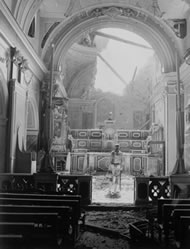 Another difference between existing WWII histories and The War is that Burns tells his story from a specifically American perspective, even though the war had been raging in Europe and Asia for more than two years before the United States entered it. “We make it very clear that the most consequential battles, the greatest loss of life, are taking place in the Soviet Union on the Eastern Front, and then, of course, in Eastern Europe,” says Burns. “But it is true, also, that without American power, without the sacrifice of American lives, the outcome would have been very different. We, and to a much lesser extent the British, were truly fighting a world war, and the only one of the combatants who was doing that. And we went from having an army in 1940 the size of Romania’s smaller than Romania’s to being the greatest power on earth. It was a huge, huge transformation.”
Another difference between existing WWII histories and The War is that Burns tells his story from a specifically American perspective, even though the war had been raging in Europe and Asia for more than two years before the United States entered it. “We make it very clear that the most consequential battles, the greatest loss of life, are taking place in the Soviet Union on the Eastern Front, and then, of course, in Eastern Europe,” says Burns. “But it is true, also, that without American power, without the sacrifice of American lives, the outcome would have been very different. We, and to a much lesser extent the British, were truly fighting a world war, and the only one of the combatants who was doing that. And we went from having an army in 1940 the size of Romania’s smaller than Romania’s to being the greatest power on earth. It was a huge, huge transformation.”
To get a handle on the mass of material, Burns and his team narrowed their focus to four American communities: Mobile, Alabama; Waterbury, Connecticut; Luverne, Minnesota; and Sacramento, California. The War takes the stories of 50 individuals from these four towns and intertwines them into one story, an “epic poem,” as Burns describes it, one that he intends to represent the entire American experience. “These four towns could have been any four towns,” he says. “These people could have been anybody. In fact, what we tried to get at were universal human concerns.” By getting to know not only them but the town, the people they left behind, the movie palaces where their loved ones would anxiously look at the newsreels, you get the sense of the country at work, transforming itself from the Depression into this vast, mighty war machine.”
Some of the stories come from the mouths of those who witnessed them. “You get to meet 50 people, 40 of whom are alive. That is to say we have interviews with them,” explains Burns. “Another 10 did not survive to the present, so we’ve had to characterize them with voices read by actors, like Tom Hanks and Samuel L. Jackson, Josh Lucas, Eli Wallach, Kevin Conway, Bobby Cannavale, Adam Arkin, a really great, stellar cast to bring these 10 people to life.”
Burns characterizes The War as an ensemble piece, with no central character dominating the proceedings the way historian Shelby Foote did in The Civil War. Still, he says, “if there is a Greek chorus, a one-man Greek chorus, it’s Al McIntosh, and Tom Hanks’s performance, to me, should be Emmy-winning.”
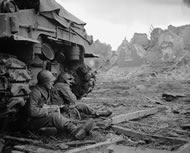 Al McIntosh was the owner and editor of the Rock County Star Herald in Luverne. Throughout the war he provided insightful commentary about life on the home front. In episode four, Hanks reads McIntosh’s words about how news of the D-Day invasion of Normandy reached the small Minnesota town on June 6, 1944. “When we stumbled sleepily down the hall to answer the ringing telephone, we made a mental note that it was shortly before 3 a.m.,” Hanks reads, sounding suitably weary. “We picked up the receiver thinking it was Sheriff Roberts calling to say there had been an accident. Instead, it was Mrs. Lloyd Long, playing the feminine counterpart of Paul Revere, saying “Get up, Al, and listen to the radio. The invasion has started.” We sat by the radio for over an hour, listening to the breathtaking announcements. And then we went to bed, to lie there for a long time, wide-eyed in the darkness, thinking, “What Rock County boys are landing on French soil tonight?”
Al McIntosh was the owner and editor of the Rock County Star Herald in Luverne. Throughout the war he provided insightful commentary about life on the home front. In episode four, Hanks reads McIntosh’s words about how news of the D-Day invasion of Normandy reached the small Minnesota town on June 6, 1944. “When we stumbled sleepily down the hall to answer the ringing telephone, we made a mental note that it was shortly before 3 a.m.,” Hanks reads, sounding suitably weary. “We picked up the receiver thinking it was Sheriff Roberts calling to say there had been an accident. Instead, it was Mrs. Lloyd Long, playing the feminine counterpart of Paul Revere, saying “Get up, Al, and listen to the radio. The invasion has started.” We sat by the radio for over an hour, listening to the breathtaking announcements. And then we went to bed, to lie there for a long time, wide-eyed in the darkness, thinking, “What Rock County boys are landing on French soil tonight?”
The War tells stories about other people like McIntosh, people who never came within a thousand miles of a battlefield, who worked in war factories, watched newsreels about the battles, and followed the arrows on the world maps in their newspapers. Too often, they received telegrams from the War Department that suddenly, tragically, brought home the cost of making those map arrows move. The entire nation was at war. “We have to understand it as the greatest concerted effort in American history,” says Burns. “There were no red states. There were no blue states. Everybody had their oar in the water, pulling the same direction. And I think the lessons of the Second World War, without beating anyone over the head, are very much about how we agreed to cohere as a country.”
But The War is not just about the home front. Burns sought also to provide an intimate view of battle, through film footage and the recollections of people who fought on the battlefields of Europe and the Pacific. “We wrap our wars, as they recede into the distance, with bloodless, gallant myth, obscuring its causes and its outcomes, but more important, what it was actually like to be in that war,” Burns says. With The War, he wanted to bring home the experience of war, with all its paradoxes and horrors. “In fact the Second World War, for the past few decades, has been called the Good War. How could it possibly be the Good War? It’s the worst war ever. It’s the greatest event in human history and the greatest cataclysm in human history, resulting in the deaths of nearly 60 million human beings.”
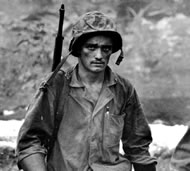 Still, there’s undeniably something about war that fascinates us. “When I did the Civil War series 17 years ago,” says Burns, “the opening quote was from Oliver Wendell Holmes, Jr., who was wounded six times in that war and later went on to become a justice of the United States Supreme Court. He was talking about the war and he said, “We have shared the incommunicable experience of war. We have felt, we still feel, the passion of life at its top. In our youths, our hearts were touched with fire.” Holmes was trying to put into words what every soldier who has ever faced combat knows in his or her guts: that, paradoxically, when your life is most threatened, when violent death is possible at any moment, everything is vivified, the intensity and experience of life are heightened to a degree not felt in ordinary life. So war, which is so obviously repellent and terrifying, also has an aspect to it which is compelling to some people, attractive. And we wanted to get at that essence of what it is. And I think we have.”
Still, there’s undeniably something about war that fascinates us. “When I did the Civil War series 17 years ago,” says Burns, “the opening quote was from Oliver Wendell Holmes, Jr., who was wounded six times in that war and later went on to become a justice of the United States Supreme Court. He was talking about the war and he said, “We have shared the incommunicable experience of war. We have felt, we still feel, the passion of life at its top. In our youths, our hearts were touched with fire.” Holmes was trying to put into words what every soldier who has ever faced combat knows in his or her guts: that, paradoxically, when your life is most threatened, when violent death is possible at any moment, everything is vivified, the intensity and experience of life are heightened to a degree not felt in ordinary life. So war, which is so obviously repellent and terrifying, also has an aspect to it which is compelling to some people, attractive. And we wanted to get at that essence of what it is. And I think we have.”
One thing that has remained consistent since World War II, Burns says, is the ordinary soldier’s view of battle. War is still war, whether it’s in Iraq or on Tarawa. “We called this film The War,” he says. “We didn’t call it The Second World War or World War II. Because getting at that experience of what it was like to be in that war, we’re essentially talking about all war. So you could import a soldier from the Iraq War and they would say, “Yeah, it’s just like that now.” You could also import a soldier from the Peloponnesian Wars and they would say, “Yeah, our officers didn’t know what they were doing. They didn’t give us the right equipment. Our spears were shorter than their spears.” Whatever it is, it’s all the same.”
Burns had already started working on his latest film when war reached the United States again, on September 11, 2001, with terrorist attacks that have been compared to the Japanese attack on Pearl Harbor. Burns finds the comparison apt, saying that “in some ways 9/11 is a much more terrifying attack.” He goes on to explain that “Pearl Harbor is the most remote place on earth,” while 9/11 made it clear that we can’t count on the “two mighty oceans, east and west, which have protected us.” Yet Pearl Harbor awoke the country as 9/11 did.
Burns found that the World Trade Center attack made his interviews with some of his subjects more poignant than they otherwise might have been. “I think 9/11 helped to open them up, because they felt such a similarity at what was going on,” he says. At the same time, there was a sense that in this latest war, the country was not coming together. “You can feel a great frustration among that generation for how we’ve handled it, how we’ve squandered the opportunity at unity,” Burns says.
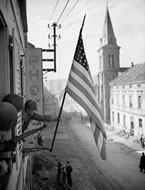 Despite the connections to 9/11 and its consequences, Burns asserts that his film “does not have an ax to grind or a political bone in its body. It just wants to tell what happened. But audiences can’t help but think about Iraq or about Abu Ghraib, or torture, or treatment of prisoners, or weapons. You can’t do it. It doesn’t even matter what your politics are. One hopes that people begin to see how incredibly small politics actually is on the scope of other things.” Burns believes that art, including documentary filmmaking, has the ability to capture a fuller and far more nuanced picture of past events than politics and ideology can, and in The War, he says, “I think that’s what we’ve done. Audiences of every different political stripe have responded so positively to this film.”
Despite the connections to 9/11 and its consequences, Burns asserts that his film “does not have an ax to grind or a political bone in its body. It just wants to tell what happened. But audiences can’t help but think about Iraq or about Abu Ghraib, or torture, or treatment of prisoners, or weapons. You can’t do it. It doesn’t even matter what your politics are. One hopes that people begin to see how incredibly small politics actually is on the scope of other things.” Burns believes that art, including documentary filmmaking, has the ability to capture a fuller and far more nuanced picture of past events than politics and ideology can, and in The War, he says, “I think that’s what we’ve done. Audiences of every different political stripe have responded so positively to this film.”
The theme of unity, of cohesion, is something Burns cares about. “The historian Arthur Schlesinger, Jr., just died a couple of months ago, and he said, many years ago, there’s too much pluribus and not enough unum. And he’s absolutely right. I think I’ve devoted most of my professional life to trying to be about unum and no more so than in this film.”
It’s somewhat ironic, then, that the first controversy over The War arrived with charges that Burns was not being inclusive enough. Last spring, two groups that represent Hispanic Americans, the American GI Forum and the Hispanic Association of Corporate Responsibility accused Burns of ignoring the contributions Hispanic Americans made to the war effort. “Part of the problem was that they didn’t want something they knew would become definitive although how could any film become definitive about the Second World War? without their inclusion,” says Burns. “I tried to say, “Look, we don’t do Irish Americans, and we don’t do this, and we don’t do that. It’s not about that. We’re after these universal human concerns.” But of course politics and art don’t mix. It’s oil and water. They don’t talk to each other. They couldn’t hear me, so I finally thought, well, let me listen to them. So we said, okay, let’s go back and do some stories. So we found some stories and found also a Native American one which is unbelievable, and we’ve just added it to the ends of a couple of the episodes. And they’re fantastic. I’ve just been working on them today. It’s a way of not leaving the project.”
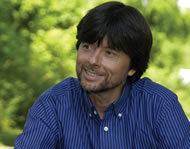 Early reactions to The War have been very encouraging, says Burns: “I had a veteran come up to me in tears after he’d seen a lot of the film. He said, “I’ve waited all of my life for someone to tell it like it really was. This is the closest I’ve ever seen it.” Cadets at West Point who saw some scenes from the series responded with two standing ovations, as did an audience in San Francisco a week later. “I just came back from the Cannes Film Festival, where they showed the entire 14 1/2 hours of the film,” says Burns. “The French were just weeping, and this film doesn’t deal with the French. We talk about the invasion, and we liberate Paris, but it’s not about them. It’s about us and our perspective, but they saw in our perspective their experience as well. And there was a Czech guy there, and a Norwegian guy there, and a Brit there, and a Russian, and they all felt the same way.”
Early reactions to The War have been very encouraging, says Burns: “I had a veteran come up to me in tears after he’d seen a lot of the film. He said, “I’ve waited all of my life for someone to tell it like it really was. This is the closest I’ve ever seen it.” Cadets at West Point who saw some scenes from the series responded with two standing ovations, as did an audience in San Francisco a week later. “I just came back from the Cannes Film Festival, where they showed the entire 14 1/2 hours of the film,” says Burns. “The French were just weeping, and this film doesn’t deal with the French. We talk about the invasion, and we liberate Paris, but it’s not about them. It’s about us and our perspective, but they saw in our perspective their experience as well. And there was a Czech guy there, and a Norwegian guy there, and a Brit there, and a Russian, and they all felt the same way.”
From pluribus, unum.
Photo credits: National Archives, except the photo of Sacramento, which is the Sacramento Bee Collection, Sacramento Archives and Museum Collection Center, courtesy of PBS, and the portrait of Ken Burns, by Cable Risdon, courtesy of PBS.
Copyright 310 Publishing, LLC. All rights reserved.


FOLLOW US »
